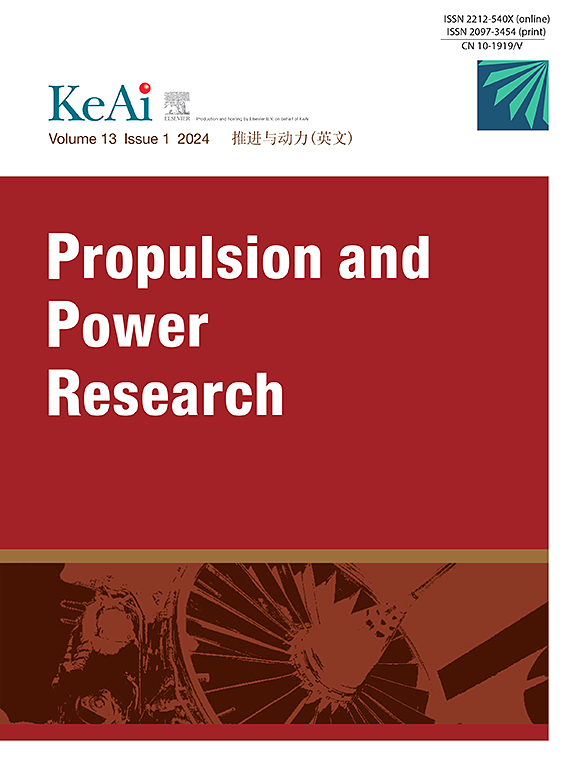Auto-updating model-based control for thrust variation mitigation and acceleration performance enhancement of gas turbine aero-engines
IF 5.4
2区 工程技术
Q1 ENGINEERING, AEROSPACE
引用次数: 0
Abstract
Model-based control shows promising potential for engine performance improvement and future aero-propulsion requirements. In this paper, an auto-updating thrust variation mitigation (AuTVM) control approach using on-board model strategies is proposed for gas turbine aero-engines under in-service degradation effects, which aims at active thrust regulation and acceleration protection in a simultaneous way. The AuTVM control is integrated with an on-line block, based on a reliable on-board engine model, and an off-line part for the periodical update of control parameters via post-flight engine monitoring data. The core feature of the AuTVM control is a set of auto-updating loops within the on-line part, including thrust regulation loop, surge margin loop, turbine entry temperature loop, and the steady loop, whose control parameters are periodically adjusted with increasing flight cycles. Meanwhile, an industrial sensor-based baseline controller and two tailored model-based controllers, i.e., a thrust variation mitigation (TVM) controller with fixed gains and a self-enhancing active transient protection (SeATP) controller with pro-active transient protection and passive thrust control, are also developed as comparison bases. Numerical simulations for idle to full-power acceleration tests are carried on a validated aero-thermal turbofan engine model using publicly available degradation data. Simulation results demonstrate that both new engines and severely degraded engines regulated by the AuTVM controller show significant thrust response enhancement, compared to the baseline controller. Moreover, thrust variation at the maximum steady state of degraded engines, which exists within the SeATP controller and the baseline controller, is suppressed by the proposed AuTVM controller. Robustness analysis against degradation uncertainties and sensor accuracy confirms that the AuTVM controller owns a closer maximum steady-state thrust distribution to the desired value than those of the SeATP and the baseline controller while utilizing transient margins of controlled engines more effectively. Hence, the control performance of the AuTVM controller for in-service engines is guaranteed.
基于自动更新模型的燃气涡轮航空发动机推力变化抑制与加速性能提高控制
基于模型的控制显示了发动机性能改进和未来航空推进需求的巨大潜力。针对在役燃气涡轮航空发动机的退化效应,提出了一种基于机载模型策略的自动更新推力变化缓解(AuTVM)控制方法,旨在同时实现主动推力调节和加速度保护。AuTVM控制集成了基于可靠的机载发动机模型的在线模块和通过飞行后发动机监测数据定期更新控制参数的离线部分。AuTVM控制的核心特征是在线部分的一组自动更新回路,包括推力调节回路、喘振裕度回路、涡轮入口温度回路和稳态回路,其控制参数随飞行周期的增加而周期性调整。同时,还开发了基于工业传感器的基线控制器和基于定制模型的两种控制器,即具有固定增益的推力变化缓解(TVM)控制器和具有主动暂态保护和被动推力控制的自增强主动暂态保护(SeATP)控制器,作为比较基础。利用公开的退化数据,在一个经过验证的气动热涡扇发动机模型上进行了怠速到全功率加速试验的数值模拟。仿真结果表明,与基线控制器相比,AuTVM控制器控制的新发动机和严重退化发动机的推力响应都有显著提高。此外,存在于SeATP控制器和基线控制器中的退化发动机最大稳态推力变化被所提出的AuTVM控制器所抑制。对退化不确定性和传感器精度的鲁棒性分析证实,AuTVM控制器比SeATP和基线控制器具有更接近期望值的最大稳态推力分布,同时更有效地利用被控发动机的瞬态余量。从而保证了AuTVM控制器对在役引擎的控制性能。
本文章由计算机程序翻译,如有差异,请以英文原文为准。
求助全文
约1分钟内获得全文
求助全文
来源期刊

Propulsion and Power Research
Multiple-
CiteScore
7.50
自引率
5.70%
发文量
30
期刊介绍:
Propulsion and Power Research is a peer reviewed scientific journal in English established in 2012. The Journals publishes high quality original research articles and general reviews in fundamental research aspects of aeronautics/astronautics propulsion and power engineering, including, but not limited to, system, fluid mechanics, heat transfer, combustion, vibration and acoustics, solid mechanics and dynamics, control and so on. The journal serves as a platform for academic exchange by experts, scholars and researchers in these fields.
 求助内容:
求助内容: 应助结果提醒方式:
应助结果提醒方式:


